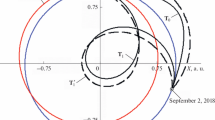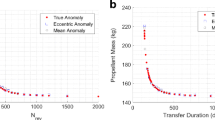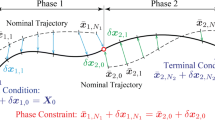Abstract
Global 4-D trajectory (x, y, z, t) is optimized for a spacecraft, which is launched from the Earth to fly around the Sun, just as star-drift of 1437 asteroids in the solar system. The spacecraft trajectory is controlled by low thrust. The performance index of optimal trajectory is to maximize the rendezvous times with the intermediate asteroids, and also maximize the final mass. This paper provides a combined algorithm of global 4-D trajectory optimization. The algorithm is composed of dynamic programming and two-point-boundary algorithm based on optimal control theory. The best 4-D trajectory is obtained: the spacecraft flies passing 55 asteroids, and rendezvous with (following or passing again) asteroids for 454 days, and finally rendezvous with the asteroid 2005SN25 on the day 60521 (MJD), the final mass of the spacecraft is 836.53 kg.
Similar content being viewed by others
References
The 4th Global Trajectory Optimization Competition, http://cct.cnes.fr/cct02/gtoc4/index.htm, 2009
Betts J T. Survey of numerical methods for trajectory optimization. J Guidance Control Dyn, 1998, 21: 193–205
Wall B J, Conway B A. Shape-based approach to low-thrust rendezvous trajectory design. J Guidance Control Dyn, 2009, 32: 96–101
Kechichian J A. Reformulation of Edelbaum’s low-thrust transfer problem using optimal control theory. J Guidance Control Dyn, 1997, 20: 988–994
Petropoulos A E, Longuski J M. Shape-based algorithm for automated design of low-thrust, gravity-assist trajectories. J Spac Rock, 2004, 41: 787–796
Petropoulos A. Refinements to the Q-law for low-thrust orbit transfers. American Astronautical Society Paper, 2005. 5–162
Nan Y, Chen S L, Yan H. A common numerical calculation method of optimizing the trajectories of space vehicles (in Chinese). J Flight Dyn, 1996, 14: 20–26
Nan Y, Lu Y P, Gong P. Optimal reentry trajectory design for moon-craft returning to the Earth (in Chinese). J Astronaut, 2009, 30: 1842–1847
Nan Y, Lu Y P, Gong P. Trajectory optimization for free flight in air traffic control (in Chinese). J Syst Simul, 2009, 20(Suppl): 234–238
Nan Y, Peng Y. An effective algorithm of terrain Avoidance/terrain following (in Chinese). J Flight Dyn, 2006, 24: 73–75
Author information
Authors and Affiliations
Corresponding author
Rights and permissions
About this article
Cite this article
Nan, Y., Huang, G., Lu, Y. et al. Global 4-D trajectory optimization for spacecraft. Sci. China Technol. Sci. 53, 2097–2101 (2010). https://doi.org/10.1007/s11431-010-3031-7
Received:
Accepted:
Published:
Issue Date:
DOI: https://doi.org/10.1007/s11431-010-3031-7




